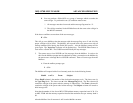
MFJ-1278B MULTI-MODE ADVANCED OPERATION
Enforcing a channel access delay for all stations on the channel for whom the packet that
caused the queue was not intended (& who therefore aren't going to ACK it) allows even
ACKs from hidden terminals to get back to the expecting station. This clears that traffic from
the offered load list. If the packet was indeed copied and ACKed, further retrys of the same
information will not be necessary.
New Parameters
There are several new parameters that relate to this modification of the protocol. They are as
follows:
ACKPRIOR ON|OFF
This enables prioritized acknowledgments if turned on.
If ACKprior is turned off and SLots (see below) is set to 0, this modification of the AX.25
protocol is effectively disabled. The MFJ-1278B will behave like normal AX.25 protocol.
Being independent of each other, the enabling and disabling of slotted channel access and
Prioritized acknowledgments are the same. So you could if you wished run normal AX.25
with slotted channel access or the new protocol without slotted channel access.
DEADTIME 0 - 250 (each increment represents 10 milliseconds)
This is the time between when a remote TNC has pressed PTT and when the local TNC can
reasonably be expected to detect this fact.
This must be set to a value that accounts for the slowest acceptable station on the channel. It
includes the time required for the remote station's radio to come on the air properly after
assertion of PTT (TXDelay) and the time required for the local station's squelch (if used) and
TNC DCD circuits to allow generation of a "DCD true" signal in the local TNC. Ideally,
once the proper value for this timer is ascertained, all stations on the channel will use the
same value.
Very preliminary testing done here on VHF indicates that measurements of the above delay
times should be multiplied by 1.5 for use as the DEAdtime parameter. We had carefully
measured the times for all stations participating in our tests. This gave us a worst case delay
total of 210 milliseconds. When we ran the test, we were still getting about a 5 percent
collision rate on the acknowledgments. We were required to increase the DEAdtime
parameter to 30 (300 milliseconds) to completely eliminate collisions with ACKs.
The current default for this parameter is a ridiculously short 30 milliseconds. This represents


















